Discover 50 hidden attractions, cool sights, and unusual things to do in India. Don't miss out on these must-see attractions: Taj Mahal (Agra), Agra Fort (Agra) or Humayun's Tomb (Delhi).
Below, you can find the list of the most amazing places you should visit in India.
Table of Contents
Taj Mahal, Agra

Also known as: ताजमहल
Iconic Mughal mausoleum. The Taj Mahal, is an ivory-white marble mausoleum on the right bank of the river Yamuna in the Indian city of Agra. It was commissioned in 1632 by the Mughal emperor Shah Jahan to house the tomb of his favourite wife, Mumtaz Mahal; it also houses the tomb of Shah Jahan himself. The tomb is the centrepiece of a 17-hectare complex, which includes a mosque and a guest house, and is set in formal gardens bounded on three sides by a crenellated wall.
Construction of the mausoleum was essentially completed in 1643, but work continued on other phases of the project for another 10 years. The Taj Mahal complex is believed to have been completed in its entirety in 1653 at a cost estimated at the time to be around ₹32 million, which in 2020 would be approximately ₹70 billion (about U.S. $1 billion). The construction project employed some 20,000 artisans under the guidance of a board of architects led by the court architect to the emperor, Ustad Ahmad Lahauri. Various types of symbolism have been employed in the Taj to reflect natural beauty and divinity.
The Taj Mahal was designated as a UNESCO World Heritage Site in 1983 for being "the jewel of Muslim art in India and one of the universally admired masterpieces of the world's heritage". It is regarded by many as the best example of Mughal architecture and a symbol of India's rich history. The Taj Mahal attracts more than 6 million visitors a year and in 2007, it was declared a winner of the New 7 Wonders of the World (2000–2007) initiative.[1]
Address: Taj Road, Agra
Agra Fort, Agra

Also known as: आगरा का किला
Mughal stronghold on ancient site. Agra Fort is a historical fort in the city of Agra in India. It was the main residence of the rulers of Sikarwar clan of rajputs until mughals occupied it and Mughal Dynasty until 1638, when the capital was shifted from Agra to Delhi. It was also known as the “Lal-Qila”, “Fort Rouge” or “Qila-i-Akbari”. Before capture by the British, the last Indian rulers to have occupied it were the Marathas. In 1983, the Agra fort was life inscribed as a UNESCO World Heritage Site. It is about 2.5 km northwest of its more famous sister monument, the Taj Mahal. The fort can be more accurately described as the walled city.
Like the rest of Agra, the history of Agra Fort prior to Mahmud Ghaznavi's invasion is unclear. However, in the 15th century, the Chauhan Rajputs occupied it. Soon after, Agra assumed the status of capital when Sikandar Lodi (A.D. 1487–1517) shifted his capital from Delhi and constructed a few buildings in the pre-existing Fort at Agra. After the first battle of Panipat (A.D. 1526) Mughals captured the fort and ruled from it. In A.D. 1530, Humayun was crowned in it. The Fort got its present appearance during the reign of Akbar (A.D. 1556–1605).[2]
Address: Agra Fort, 282003 Agra
Humayun's Tomb, Delhi
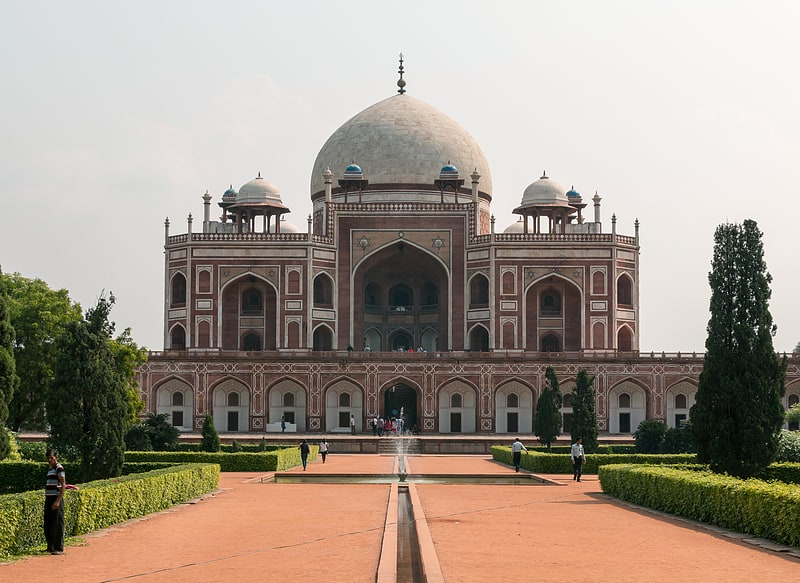
Also known as: हुमायूँ का मकबरा
Historical landmark in New Delhi, India. Humayun's tomb is the tomb of the Mughal Emperor Humayun in Delhi, India. The tomb was commissioned by Humayun's chief consort, Empress Bega Begum, in 1558, and designed by Mirak Mirza Ghiyas and his son, Sayyid Muhammad, Persian architects chosen by her. It was the first garden-tomb on the Indian subcontinent, and is located in Nizamuddin East, Delhi, India, close to the Dina-panah Citadel, also known as Purana Qila, that Humayun found in 1533. It was also the first structure to use red sandstone at such a scale. The tomb was declared a UNESCO World Heritage Site in 1993, and since then has undergone extensive restoration work, which is complete. Besides the main tomb enclosure of Humayun, several smaller monuments dot the pathway leading up to it, from the main entrance in the West, including one that even pre-dates the main tomb itself, by twenty years; it is the tomb complex of Isa Khan Niyazi, an Afghan noble in Sher Shah Suri's court of the Suri dynasty, who fought against the Mughals, constructed in 1547 CE.
The complex encompasses the main tomb of the Emperor Humayun, which houses the graves of Empress Bega Begum, Hamida Begum, and also Dara Shikoh, great-great-grandson of Humayun and son of the later Emperor Shah Jahan, as well as numerous other subsequent Mughals, including Emperor Jahandar Shah, Farrukhsiyar, Rafi Ul-Darjat, Rafi Ud-Daulat, Muhammad Kam Bakhsh and Alamgir II. It represented a leap in Mughal architecture, and together with its accomplished Charbagh garden, typical of Persian gardens, but never seen before in India, it set a precedent for subsequent Mughal architecture. It is seen as a clear departure from the fairly modest mausoleum of his father, the first Mughal Emperor, Babur, called Bagh-e Babur (Gardens of Babur) in Kabul (Afghanistan). Though the latter was the first Emperor to start the tradition of being buried in a paradise garden. Modelled on Gur-e Amir, the tomb of his ancestor and Asia's conqueror Timur in Samarkand, it created a precedent for future Mughal architecture of royal mausolea, which reached its zenith with the Taj Mahal, at Agra.
The site was chosen on the banks of Yamuna river, due to its proximity to Nizamuddin Dargah, the mausoleum of the celebrated Sufi saint of Delhi, Nizamuddin Auliya, who was much revered by the rulers of Delhi, and whose residence, Chilla Nizamuddin Auliya lies just north-east of the tomb. In later Mughal history, the last Mughal Emperor, Bahadur Shah Zafar took refuge here, during the Indian Rebellion of 1857, along with three princes, and was captured by Captain Hodson before being exiled to Rangoon. At the time of the Slave Dynasty this land was under the 'KiloKheri Fort' which was capital of Sultan Qaiqabad, son of Nasiruddin (1268–1287).
The Tombs of Battashewala Complex lie in the buffer zone of the World Heritage Site of the Humayun Tomb Complex; the two complexes are separated by a small road but enclosed within their own separate compound wall.[3]
Address: Mathura Road, 110013 New Delhi (Central Delhi)
Qutb complex, Delhi

Also known as: कुतुब परिसर
Ruins from an ancient Muslim sultanate. The Qutb Minar complex are monuments and buildings from the Delhi Sultanate at Mehrauli in Delhi, India. Construction of the Qutub Minar "victory tower" in the complex, named after the religious figure Sufi Saint Khwaja Qutbuddin Bakhtiar Kaki, was begun by Qutb-ud-din Aibak, who later became the first Sultan of Delhi of the Mamluk dynasty. It was continued by his successor Iltutmish, and finally completed much later by Firoz Shah Tughlaq, a Sultan of Delhi from the Tughlaq dynasty in 1368 AD. The Qubbat-ul-Islam Mosque, later corrupted into Quwwat-ul Islam, stands next to the Qutb Minar.
Many subsequent rulers, including the Tughlaqs, Alauddin Khalji and the British added structures to the complex. Apart from the Qutb Minar and the Quwwat ul-Islam Mosque, other structures in the complex include the Alai Darwaza gate, the Alai Minar and the Iron pillar. The Quwwat ul-Islam Mosque was originally built from the remains of 27 older Hindu and Jain temples. The pillars of the temples were reused and the original images plastered over. Inside the complex lie the tombs of Iltutmish, Alauddin Khalji and Imam Zamin.
Today, the adjoining area spread over with a host of old monuments, including Balban's tomb, has been developed by the Archaeological Survey of India (ASI) as the Mehrauli Archaeological Park, and INTACH has restored some 40 monuments in the Park. It is also the venue of the annual 'Qutub Festival', held in November–December, where artists, musicians and dancers perform over three days.[4]
Red Fort, Delhi
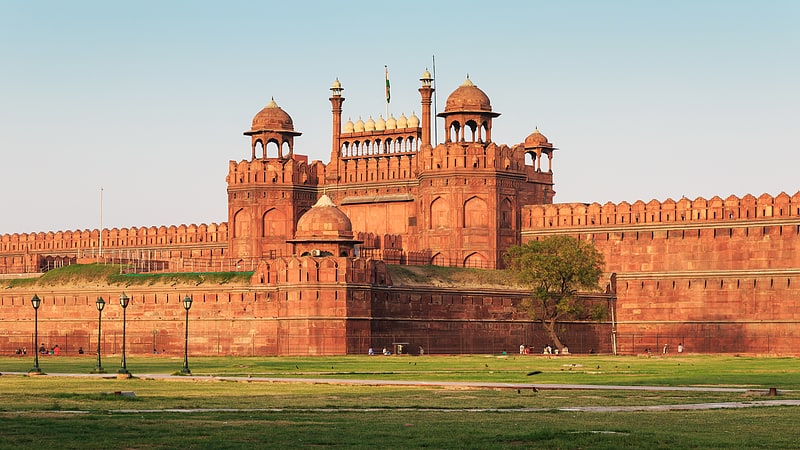
Also known as: लाल क़िला
Iconic 1600s imperial residence and museum. The Red Fort or Lal Qila is a historic fort in Old Delhi, Delhi in India that served as the main residence of the Mughal Emperors. Emperor Shah Jahan commissioned construction of the Red Fort on 12 May 1638, when he decided to shift his capital from Agra to Delhi. Originally red and white, its design is credited to architect Ustad Ahmad Lahori, who also constructed the Taj Mahal. The fort represents the peak in Mughal architecture under Shah Jahan, and combines Persianate palace architecture with Indian traditions.
The fort was plundered of its artwork and jewels during Nadir Shah's invasion of the Mughal Empire in 1739. Most of the fort's marble structures were subsequently demolished by the British following the Indian Rebellion of 1857. The fort's defensive walls were largely undamaged, and the fortress was subsequently used as a garrison.
On 15 August 1947, the first Prime Minister of India, Jawaharlal Nehru, raised the Indian flag above the Lahori Gate. Every year on India's Independence Day (15 August), the Prime Minister hoists the Indian tricolour flag at the fort's main gate and delivers a nationally broadcast speech from its ramparts.
The Red Fort was designated a UNESCO World Heritage Site in 2007 as part of the Red Fort Complex.[5]
Address: Netaji Subhash Marg, 110006 New Delhi (Central Delhi)
New Market, Kolkata
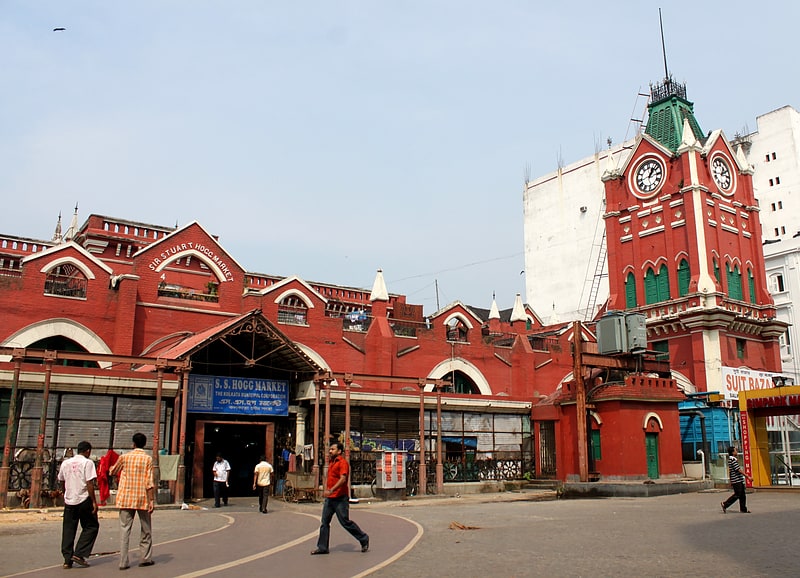
Shopping center in Kolkata, India. The New Market, formerly known as Sir Stuart Hogg Market, is a market in Kolkata situated on Lindsay Street, beside Free School Street. Although primarily "New Market" referred to the original enclosed market, today in local parlance, the entire shopping area is often known as "New Market".[6]
Address: Kolkata, Lindsay Street
Hawa Mahal, Jaipur
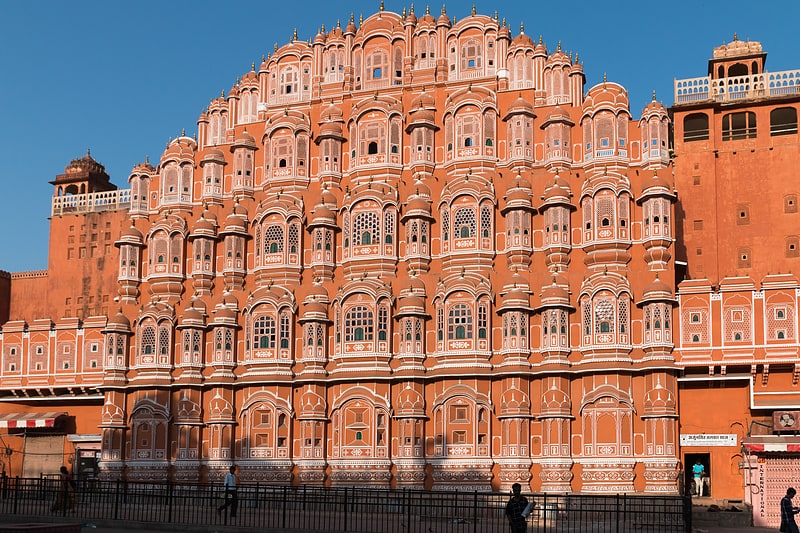
Also known as: हवामहल
Palace in Jaipur, India. The Hawa Mahal is a palace in the city of Jaipur, India. Built from red and pink sandstone, the palace sits on the edge of the City Palace, Jaipur, and extends to the Zenana, or women's chambers.
The structure was built in 1799 by the Maharaja Sawai Pratap Singh, the grandson of Maharaja Sawai Jai Singh, who was the founder of the city of Jaipur, India. He was so inspired by the unique structure the of Khetri Mahal that he built this grand and historical palace.
It was designed by Lal Chand Ustad. Its five-floor exterior is akin to a honeycomb with its 953 small windows called Jharokhas decorated with intricate latticework. The original intent of the lattice design was to allow royal ladies to observe everyday life and festivals celebrated in the street below without being seen, since they had to obey the strict rules of "purdah", which forbade them to appear in public without face coverings. This architectural feature also allowed cool air from the Venturi effect to pass through, thus making the whole area more pleasant during the high temperatures in summer. Many people see the Hawa Mahal from the street view and think it is the front of the palace, but it is the back.
In 2006, renovation works on the Mahal were undertaken, after a gap of 50 years, to give a facelift to the monument at an estimated cost of Rs 4.568 million. The corporate sector lent a hand to preserve the historical monuments of Jaipur and the Unit Trust of India has adopted Hawa Mahal to maintain it. The palace is an extended part of a huge complex. The stone-carved screens, small casements, and arched roofs are some of the features of this popular tourist spot. The monument also has delicately modelled hanging cornices.[7]
Address: Hawa Mahal Road, 302002 Jaipur
Victoria Memorial, Kolkata

Also known as: विक्टोरिया मेमोरियल
Museum in Kolkata, India. The Victoria Memorial is a large marble building in Central Kolkata, which was built between 1906 and 1921. It is dedicated to the memory of Queen Victoria, now a museum under the auspices of the Ministry of Culture, and is the largest monument in the world which is dedicated to a royal. The memorial lies on the Maidan and is one of the famous monuments of Kolkata.[8]
Address: 1, Queens Way, 700071 Kolkata
Kanheri Caves, Mumbai
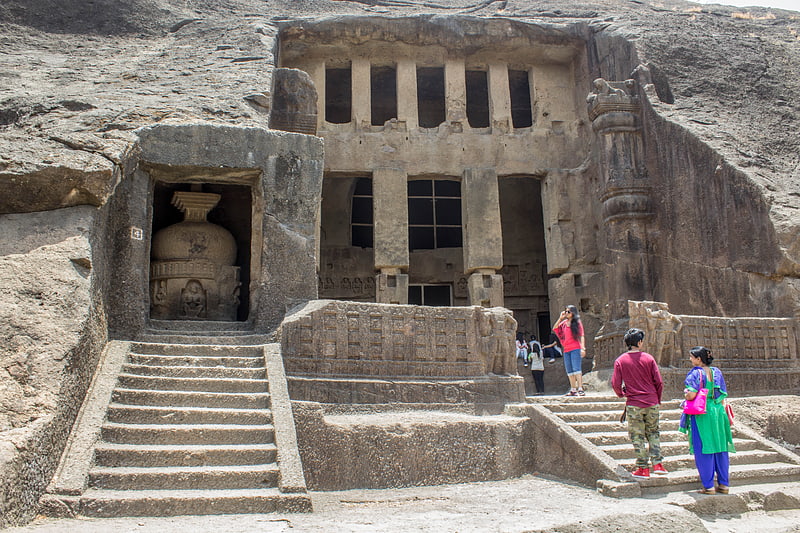
Also known as: कान्हेरी गुफाएँ
Rock hewn temples with Buddhist shrines. The Kanheri Caves are a group of caves and rock-cut monuments cut into a massive basalt outcrop in the forests of the Sanjay Gandhi National Park, on the former island of Salsette in the western outskirts of Mumbai, India. They contain Buddhist sculptures and relief carvings, paintings and inscriptions, dating from the 1st century CE to the 10th century CE. Kanheri comes from the Sanskrit Krishnagiri, which means black mountain.
The site is on a hillside, and is accessible via rock-cut steps. The cave complex comprises one hundred and nine caves. The oldest are relatively plain and unadorned, in contrast to later caves on the site, and the highly embellished Elephanta Caves of Mumbai. Each cave has a stone plinth that functioned as a bed. A congregation hall with huge stone pillars contains a stupa (a Buddhist shrine). Rock-cut channels above the caves fed rainwater into cisterns, which provided the complex with water. Once the caves were converted to permanent monasteries, their walls were carved with intricate reliefs of Buddha and the Bodhisattvas. Kanheri caves were built in the 1st century and had become an important Buddhist settlement on the Konkan coast by the 3rd century CE.
Most of the caves were Buddhist viharas, meant for living, studying, and meditating. The larger caves, which functioned as chaityas, or halls for congregational worship, are lined with intricately carved Buddhist sculptures, reliefs, pillars and rock-cut stupas. Avalokiteshwara is the most distinctive figure. The large number of viharas demonstrates there was a well organized establishment of Buddhist monks. This establishment was also connected with many trade centers, such as the ports of Sopara, Kalyan, Nasik, Paithan and Ujjain. Kanheri was a University center by the time the area was under the rule of the Maurayan and Kushan empires. In the late 10th century, the Buddhist teacher Atisha (980–1054) came to the Krishnagiri Vihara to study Buddhist meditation under Rahulagupta.[9]
Address: in Sanjay Gandhi National Park,, 400103 Mumbai (Kandivali)
Elephanta Caves, Mumbai
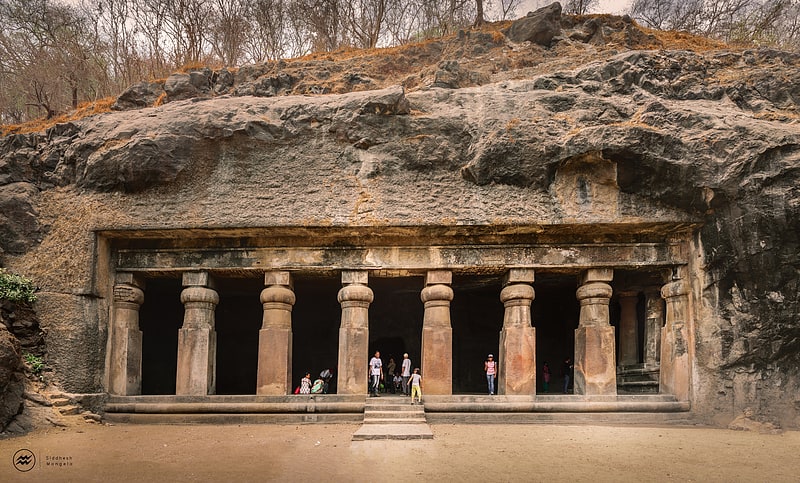
Also known as: घारापुरी गुफाएँ
Island with sculpted cave temples. Designated by UNESCO as a World Heritage Site, the Elephanta Caves are a collection of cave temples predominantly dedicated to the Hindu god Shiva. They are on Elephanta Island, or Gharapuri, in Mumbai Harbour, 10 kilometres east of Mumbai in the Indian state of Mahārāshtra. The island, about 2 kilometres west of the Jawaharlal Nehru Port, consists of five Hindu caves, a few Buddhist stupa mounds that date back to the 2nd century BCE, and two Buddhist caves with water tanks.
The Elephanta Caves contain rock cut stone sculptures, mostly in high relief, that show syncretism of Hindu and Buddhist ideas and iconography. The caves are hewn from solid basalt rock. Except for a few exceptions, much of the artwork is defaced and damaged. The main temple's orientation as well as the relative location of other temples are placed in a mandala pattern. The carvings narrate Hindu mythologies, with the large monolithic 20 feet (6.1 m) Trimurti Sadashiva (three-faced Shiva), Nataraja (Lord of dance) and Yogishvara (Lord of Yoga) being the most celebrated.
These date to between the 5th and 9th centuries, and scholars attribute them to various Hindu dynasties. They are most commonly placed between the 5th and 7th centuries. Many scholars consider them to have been completed by about 550 CE.
They were named Elefante – which morphed to Elephanta – by the colonial Portuguese who found elephant statues on the caves. They established a base on the island. The main cave (Cave 1, or the Great Cave) was a Hindu place of worship until the Portuguese arrived, whereupon the island ceased to be an active place of worship. The earliest attempts to prevent further damage to the caves were started by British India officials in 1909. The monuments were restored in the 1970s. In 1987, the restored Elephanta Caves were designated a UNESCO World Heritage Site. It is currently maintained by the Archaeological Survey of India (ASI).[10]
Address: Elephanta Caves, Mumbai
City Palace, Jaipur

Also known as: सिटी पैलेस, जयपुर
Lavish 1700s palace complex and museum. The City Palace, Jaipur was established at the same time as the city of Jaipur, by Maharaja Sawai Jai Singh II, who moved his court to Jaipur from Amber, in 1727. Jaipur is the present-day capital of the state of Rajasthan, and until 1949 the City Palace was the ceremonial and administrative seat of the Maharaja of Jaipur. The Palace was also the location of religious and cultural events, as well as a patron of arts, commerce, and industry. It now houses the Maharaja Sawai Man Singh II Museum, and continues to be the home of the Jaipur royal family. The palace complex has several buildings, various courtyards, galleries, restaurants, and offices of the Museum Trust.The MSMS II Museum Trust is headed by chairperson Rajamata Padmini Devi of Jaipur. Princess Diya Kumari runs the Museum Trust, as its secretary and trustee. She also manages The Palace School and Maharaja Sawai Bhawani Singh School in Jaipur. She founded and runs the Princess Diya Kumari Foundation to empower underprivileged and underemployed women of Rajasthan. She is also an entrepreneur. In 2013, she was elected as Member of the Legislative Assembly of Rajasthan from the constituency of Sawai Madhopur.[11]
Address: Johari Bazar, J.D.A. Market, Pink City, 302003 Jaipur
Black Taj Mahal, Agra
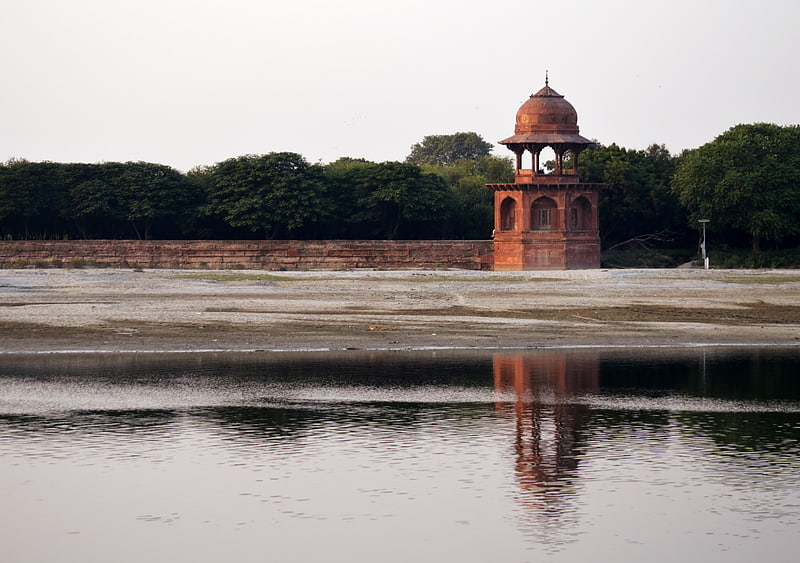
The Black Taj Mahal, also known as the Black Taj, Kaala Taj, or The Second Taj, is a legendary black marble mausoleum that is said to have been planned to be built across the Yamuna River opposite the Taj Mahal in Agra, Uttar Pradesh, India. Mughal emperor Shah Jahan is said to have desired a mausoleum for himself similar to that of the one he had built in memory of his second wife, Mumtaz Mahal.
A French traveller by the name of Jean Baptiste Tavernier who visited Agra in 1665 first mentioned the idea of Black Taj in his fanciful writings. The writings of Tavernier mention that Shah Jahan began to build his own tomb on the other side of the river but could not complete it as he was deposed by his own son Aurangzeb. However, many modern archaeologists believe this story to be myth.[12]
Jantar Mantar, Jaipur

Also known as: जन्तर मन्तर
Instruments for astronomical observation. The Jantar Mantar, Jaipur is a collection of 19 astronomical instruments built by the Rajput king Sawai Jai Singh II, the founder of Jaipur, Rajasthan. The monument was completed in 1734. It features the world's largest stone sundial, and is a UNESCO World Heritage site. It is near City Palace and Hawa Mahal. The instruments allow the observation of astronomical positions with the naked eye. The observatory is an example of the Ptolemaic positional astronomy which was shared by many civilizations.
The monument features instruments operating in each of the three main classical celestial coordinate systems: the horizon-zenith local system, the equatorial system, and the ecliptic system. The Kanmala Yantraprakara is one that works in two systems and allows transformation of the coordinates directly from one system to the other. It has the biggest sundial in the world.
The monument was damaged in the 19th century. Early restoration work was undertaken under the supervision of Major Arthur Garrett, a keen amateur astronomer, during his appointment as Assistant State Engineer for the Jaipur District.[13]
Address: Tripoliya Bazaar, 302020 Jaipur
Chhatrapati Shivaji Maharaj Vastu Sangrahalaya, Mumbai
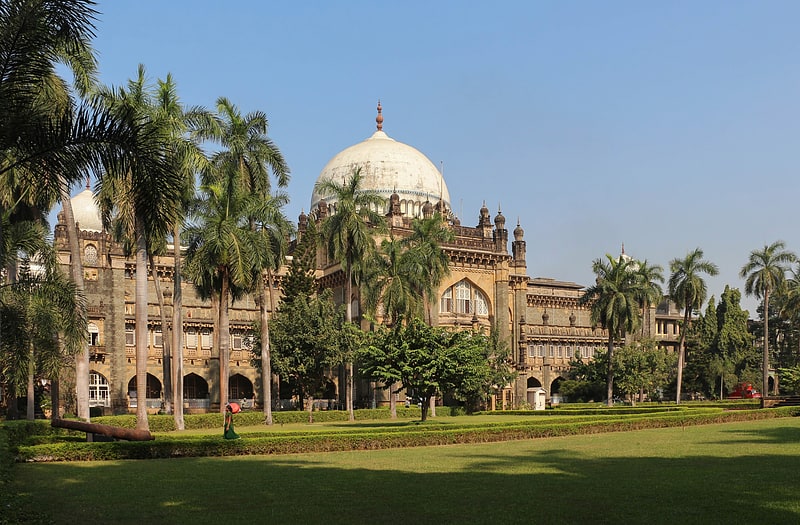
Also known as: छत्रपति शिवाजी महाराज वस्तु संग्रहालय
Museum in Mumbai, India. Chhatrapati Shivaji Maharaj Vastu Sangrahalaya, originally named Prince of Wales Museum of Western India, is a museum in Bombay which documents the history of India from prehistoric to modern times.
It was founded in the early years of the 20th century by prominent citizens of Mumbai, with the help of the government, to commemorate the visit of George V, who was Prince of Wales at the time. It is located in the heart of South Mumbai near the Gateway of India. The museum was renamed in 1998 after Shivaji, the founder of the Maratha Empire.
The building is built in the Indo-Saracenic style of architecture, incorporating elements of other styles of architecture like the Mughal, Maratha and Jain. The museum building is surrounded by a garden of palm trees and formal flower beds.
The museum houses approximately 50,000 exhibits of ancient Indian history as well as objects from foreign lands, categorised primarily into three sections: Art, Archaeology and Natural History. The museum houses Indus Valley Civilization artefacts, and other relics from ancient India from the time of the Guptas, Mauryas, Chalukyas and Rashtrakuta.[14]
Address: 159-161, Mahatma Gandhi Road, 400023 Mumbai (Colaba)
Mysore Palace, Mysore
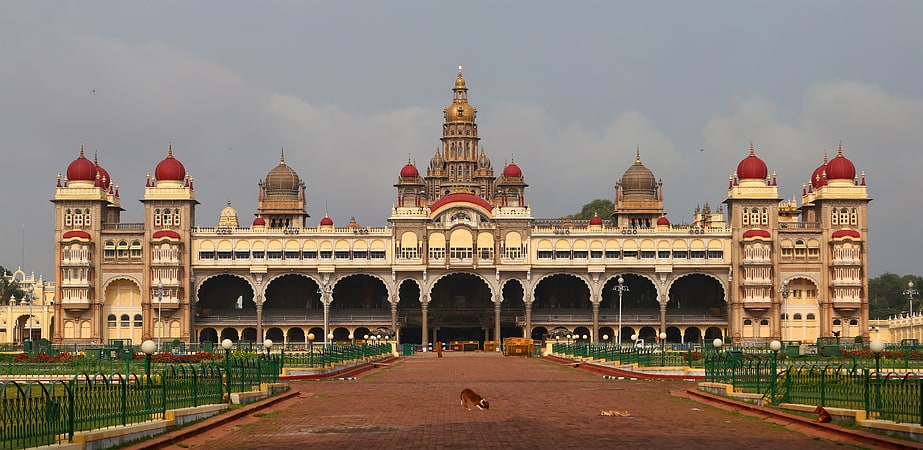
Also known as: अम्बा विलास महल
Indo-Saracenic architecture with lights. The Mysore Palace, also known as Amba Vilas Palace, is a historical palace and a royal residence. It is located in Mysore, Karnataka. It used to be the official residence of the Wadiyar dynasty and the seat of the Kingdom of Mysore. The palace is in the centre of Mysore, and faces the Chamundi Hills eastward. Mysore is commonly described as the 'City of Palaces', and there are seven palaces including this one. However, the Mysore Palace refers specifically to the one within the Old Fort.
The land on which the palace now stands was originally known as mysuru (literally, "citadel"). Yaduraya built the first palace inside the Old Fort in the 14th century, which was set ablaze and reconstructed multiple times. The Old Fort was built of wood and thus easily caught fire, while the current fort was built of stone, bricks and wood. The current structure was constructed between 1897 and 1912, after the Old Palace burnt down, the current structure is also known as the New Fort. Mysore Palace is one of the most famous tourist attractions in India, after the Taj Mahal, with more than six million annual visitors.[15]
Address: Sayyaji Rao Rd, 570001 Mysore
Sabarmati Ashram, Ahmedabad
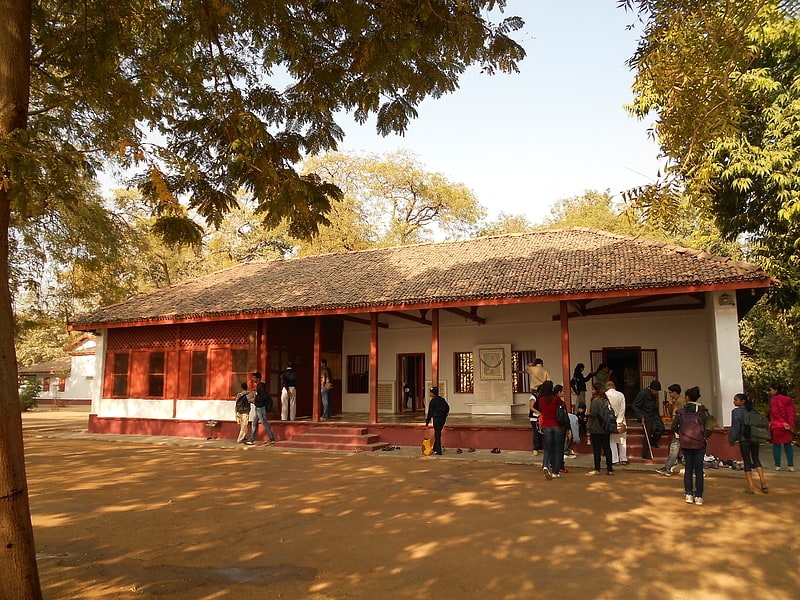
Also known as: साबरमती आश्रम
Spiritual site in Gandhi's former home. Sabarmati Ashram is located in the Sabarmati suburb of Ahmedabad, Gujarat, adjoining the Ashram Road, on the banks of the River Sabarmati, 4 miles from the town hall. This was one of the many residences of Mahatma Gandhi who lived at Sabarmati and Sevagram when he was not travelling across India or in prison. He lived in Sabarmati or Wardha for a total of twelve years with his wife Kasturba Gandhi and followers, including Vinoba Bhave. The Bhagavad Gita was recited here daily as part of the Ashram schedule.
It was from here that Gandhi led the Dandi march also known as the Salt Satyagraha on 12 March 1930. In recognition of the significant influence that this march had on the Indian independence movement, the Indian government has established the ashram as a national monument.[16]
Address: Ashram Rd, 380027 Ahmedabad
Indian Museum, Kolkata
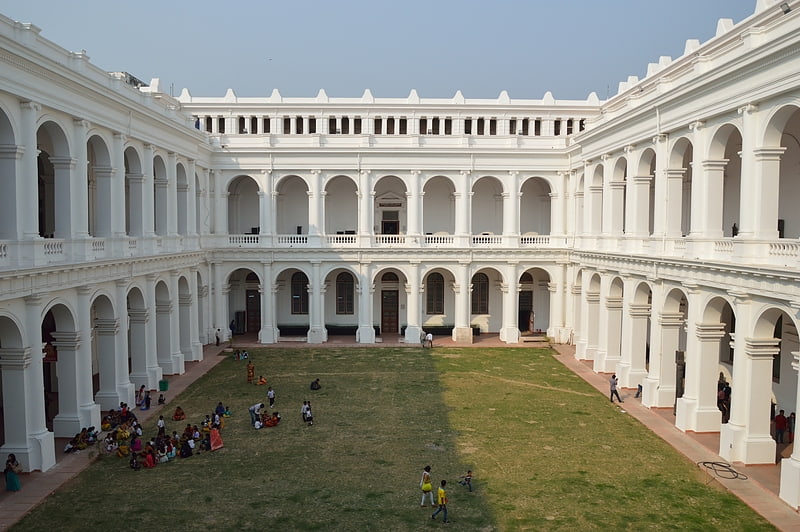
Also known as: भारतीय संग्रहालय
Cultural museum established in 1814. The Indian Museum in Central Kolkata, West Bengal, India, also referred to as the Imperial Museum at Calcutta in colonial-era texts, is the ninth oldest museum in the world, the oldest and largest museum in India. It has rare collections of antiques, armour and ornaments, fossils, skeletons, mummies and Mughal paintings. It was founded by the Asiatic Society of Bengal in Kolkata, India, in 1814. The founder curator was Nathaniel Wallich, a Danish botanist.
It has six sections comprising thirty five galleries of cultural and scientific artifacts namely Indian art, archaeology, anthropology, geology, zoology and economic botany. Many rare and unique specimens, both Indian and trans-Indian, relating to humanities and natural sciences, are preserved and displayed in the galleries of these sections. In particular the art and archaeology sections hold collections of international importance.
It is an autonomous organization under Ministry of Culture, Government of India. The present Director of the Indian Museum is Shri Arijit Dutta Choudhury who is also the Director General, NCSM and having the additional charge of Director General of National Library.
Administrative control of the Cultural sections, viz. Art, Archaeology and Anthropology rests with the Board of Trustees under its Directorate, and that of the three other science sections is with the geological survey of India, the zoological survey of India and the Botanical survey of India. The museum Directorate has eight co-ordinating service units: Education, preservation, publication, presentation, photography, medical, modelling and library. This multipurpose institution with multidisciplinary activities is being included as an Institute of national importance in the seventh schedule of the Constitution of India.[17]
Address: 27, Jawaharlal Nehru Rd, 700016 Kolkata
Garuda Mall, Bangalore
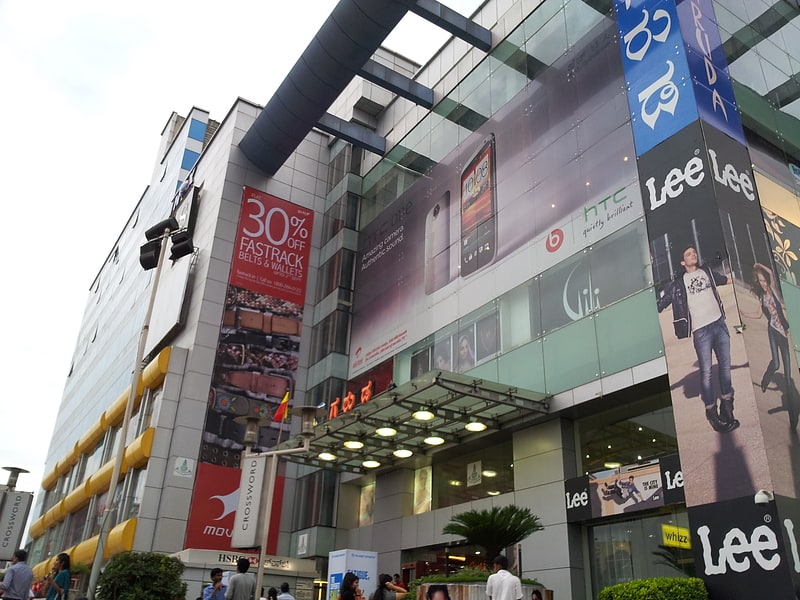
Shopping mall in Bengaluru, India. Garuda Mall is the premier shopping mall in the city of Bangalore, India, which is also home to the city’s second oldest Shoppers Stop branch, and the oldest one in the city which is attached to a mall. It is situated on Magrath Road at the heart of the central business district in Bangalore, near Brigade Road. The mall has opened another branch in the Heritage City, Mysore near K. R. Circle. Another branch in Kochi with French cuisine and heritage.[18]
Address: Bangalore, Magrath Road
City Palace, Udaipur
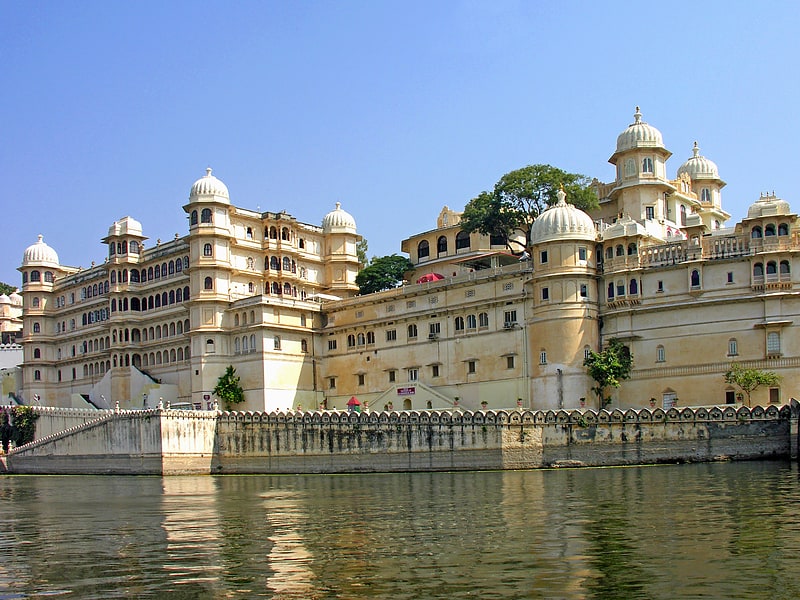
Also known as: सिटी पैलेस, उदयपुर
Lakeside complex built over 200 years. City Palace, Udaipur is a palace complex situated in the city of Udaipur in the Indian state of Rajasthan. It was built over a period of nearly 400 years, with contributions from several rulers of the Mewar dynasty. Its construction began in 1553, started by Maharana Udai Singh II of the Sisodia Rajput family as he shifted his capital from the erstwhile Chittor to the newfound city of Udaipur. The palace is located on the east bank of Lake Pichola and has several palaces built within its complex.
The City Palace in Udaipur was built in a flamboyant style and is considered the largest of its type in the state of Rajasthan. It was built atop a hill, in a fusion of the Rajasthani and Mughal architectural styles, providing a panoramic view of the city and its surroundings. Overlooking Lake Pichola, several historic monuments like the Lake Palace, Jag Mandir, Jagdish Temple, Monsoon Palace, and Neemach Mata temple, are all in the vicinity of the palace complex. Nestled within the Aravali mountain range, these landmarks are associated in popular culture with the filming of the 1983 James Bond movie Octopussy.[19]
Address: City Palace Complex, Udaipur
Salar Jung Museum, Hyderabad
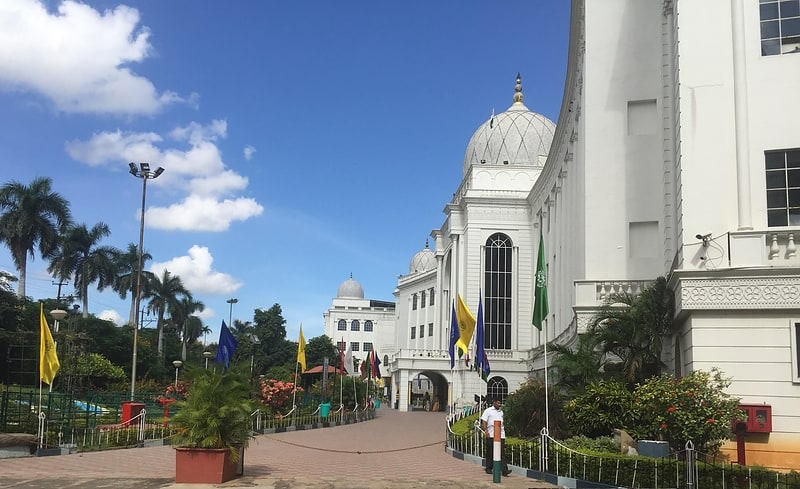
Also known as: सालार जंग संग्रहालय
Museum in Hyderabad, India. The Salar Jung Museum is an art museum located at Dar-ul-Shifa, on the southern bank of the Musi River in the city of Hyderabad, Telangana, India. It is one of the notable National Museums of India. Originally a private art collection of the Salar Jung family, it was endowed to the nation after the death of Salar Jung III. It was inaugurated on 16 December 1951.
It has a collection of sculptures, paintings, carvings, textiles, manuscripts, ceramics, metallic artifacts, carpets, clocks, and furniture from Japan, China, Burma, Nepal, India, Persia, Egypt, Europe, and North America. It is one of the largest museums in the world.[20]
Address: Salar Jung Rd, 500002 Hyderabad (Erstwhile Circle-I)
Visvesvaraya Industrial and Technological Museum, Bangalore
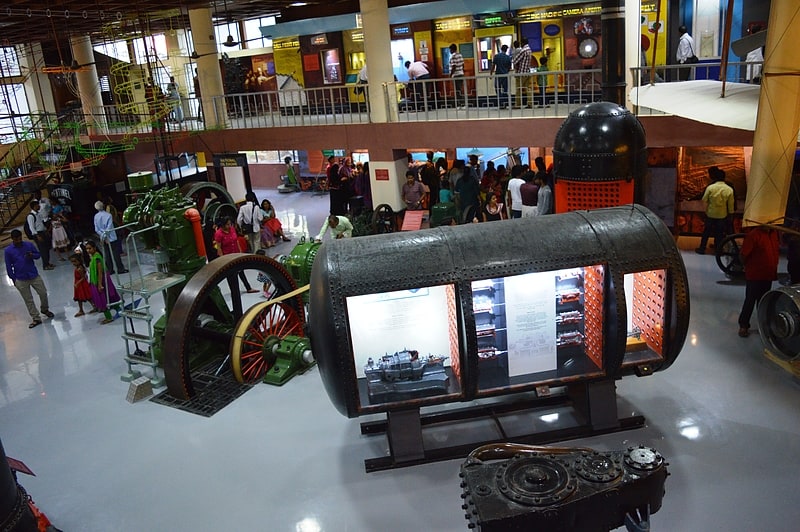
Also known as: विश्वेश्वरैया औद्योगिक एवं प्रौद्योगिकीय संग्रहालय
Museum in Bengaluru, India. The Visvesvaraya Industrial and Technological Museum, Bangalore, India, a constituent unit of the National Council of Science Museums, Ministry of Culture, Government of India, was established in memory of Bharat Ratna Sir M. Visvesvaraya. The building, with a built up area of 4,000 m2, was constructed in Cubbon Park. It houses various scientific experiments and engines, and was inaugurated by the first Prime Minister of India, Pandit Jawaharlal Nehru, on 14 July 1962. The first gallery set up at VITM, on the theme of 'Electricity', was opened to the public on 27 July 1965.[21]
Address: Kasturba Rd, 560001 Bengaluru
Meenakshi Temple, Madurai
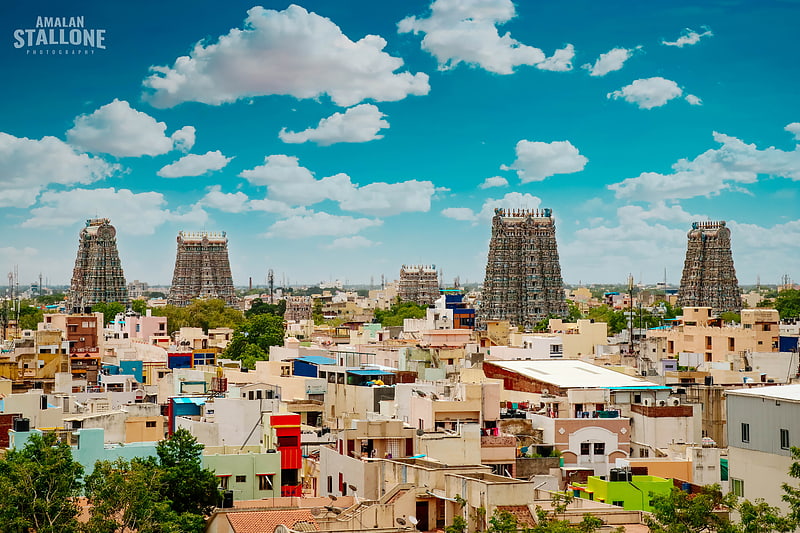
Also known as: मीनाक्षी सुन्दरेश्वर मन्दिर
Hindu temple in Madurai, India. Arulmigu Meenakshi Amman Temple, also known as Meenakshi Sundareshwarar Temple, is a historic Hindu temple located on the southern bank of the Vaigai River in the temple city of Madurai, Tamil Nadu, India. It is dedicated to the goddess Meenakshi, a form of Parvati, and her consort, Sundareshwarar, a form of Shiva. The temple is at the center of the ancient temple city of Madurai mentioned in the Tamil Sangam literature, with the goddess temple mentioned in 6th-century-CE texts. This temple is one of the Paadal Petra Sthalam. The Paadal Petra sthalam are 275 temples of lord Shiva that are revered in the verses of Tamil Saiva Nayanars of 6th-9th century CE.
The west tower (gopuram) of the temple is the model based on which the Tamil Nadu State Emblem is designed.[22]
Address: North Chitrai Street, 625001 Madurai
Khajuraho Group of Monuments, Khajuraho
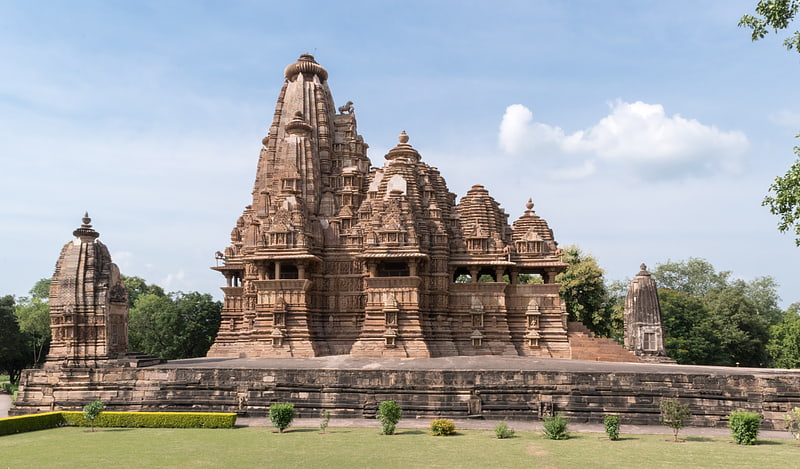
Also known as: खजुराहो स्मारक समूह
Temples of love. The Khajuraho Group of Monuments are a group of Hindu and Jain temples in Chhatarpur district, Madhya Pradesh, India, about 175 kilometres southeast of Jhansi. They are a UNESCO World Heritage Site. The temples are famous for their nagara-style architectural symbolism and less than 10% of their erotic sculptures.
Most Khajuraho temples were built between 885 AD and 1050 AD by the Chandela dynasty. Historical records note that the Khajuraho temple site had 85 temples by the 12th century, spread over 20 square kilometers. Of these, only about 25 temples have survived, spread over six square kilometers. Of the surviving temples, the Kandariya Mahadeva Temple is decorated with a profusion of sculptures with intricate details, symbolism and expressiveness of ancient Indian art.
When these monuments were built, the boys in the place lived in hermitages, by being brahmcharis (bachelor) until they attained manhood and these sculptures helped them to learn about the worldly role of 'householder'. The Khajuraho group of temples were built together but were dedicated to two religions, Hinduism and Jainism, suggesting a tradition of acceptance and respect for diverse religious views among Hindus and Jains in the region.[23]
Oberon Mall, Kochi
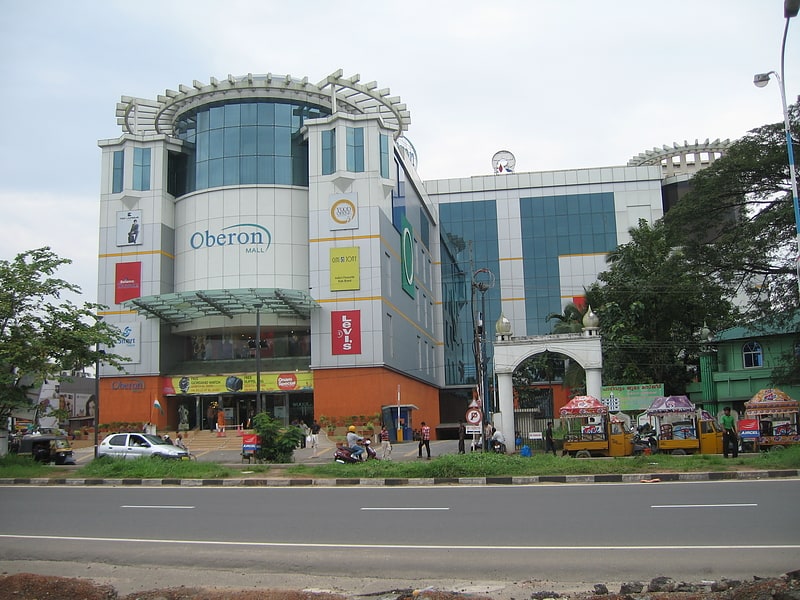
Shopping mall in India. Oberon Mall is a shopping mall located in the Indian city of Kochi. The mall was opened formally on 2 March 2009, though it was launched in 2008. The cost of construction of the mall is about ₹1 billion. It is built on an area of 350,000 square feet across five floors of shops. It also has office spaces and covers grounds of up to 6 acres.
Oberon Mall was developed and promoted by the Oberon Group of Companies, India. The mall is one of the busiest shopping avenues for the city of Kochi.
Wild Fish, a world-class seafood store from Abad Food Services which offers live, fresh and frozen seafood, opened their store in Oberon Mall. A fire broke out at Oberon Mall in May 2017 but no severe damage was reported.[24]
Address: Kochi, NH 544 Bypass, Edapally
Lal Bagh, Bangalore

Also known as: लाल बाग
Landscaped gardens and famous glasshouse. Lalbagh Botanical Garden or shortened Lalbagh, is an old botanical garden in Bangalore, India. First planned and laid out during the dalavaiship of Hyder Ali and later managed under numerous British Superintendents before Indian Independence. It was responsible for the introduction and propagation of numerous ornamental plants as well as those of economic value. It also served a social function as a park and recreational space, with a central glass house dating from 1890 which was used for flower shows. In modern times it hosts two flower shows coinciding with the week of Republic Day and Independence Day. As an urban green space along with Cubbon Park, it is also home to numerous wild species of birds and other wildlife. The garden also has a lake adjoining a large rock on which a watchtower had been constructed during the reign of Kempegowda II.[25]
Address: Lalbagh Road, 560004 Bangalore
Thirumalai Nayakkar Mahal, Madurai

Also known as: तिरुमलई नायक पैलेस
Thirumalai Nayak Palace is a 17th-century palace erected in 1636 AD by King Tirumala Nayaka, a king of Madurai's Nayaka dynasty who ruled Madurai from 1623 to 1659, in the city of Madurai, India. This Palace is a classic fusion of Italian and Rajput styles. The building, which can be seen today, was the main Palace, in which the king lived. The original Palace Complex was four times bigger than the present structure. In its heyday, the palace was considered to be one of the wonders of the South. This palace is two kilometres south east of the Meenakshi Amman Temple.[26]
Address: Madurai Main, Mahal Area, 625001 Madurai
Mysore Zoo, Mysore
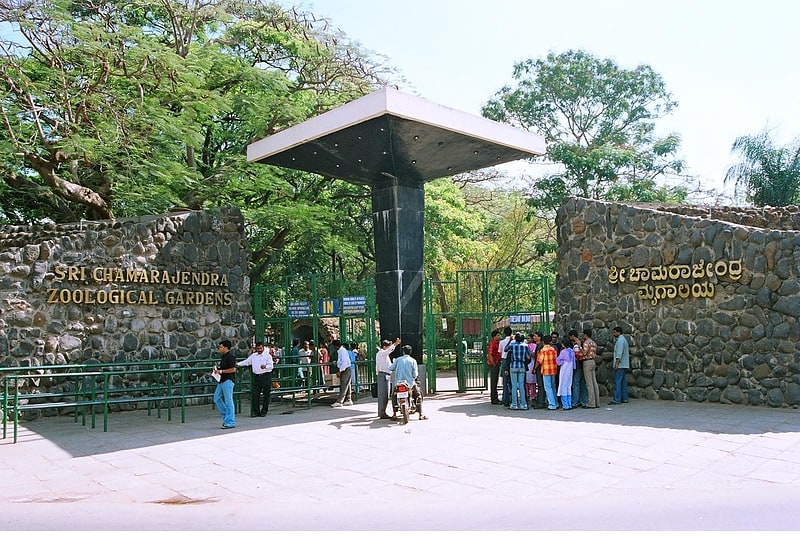
Expansive place with exotic animals. Mysore Zoo is a 157-acre zoo located near the palace in Mysore, India. It is one of the oldest and most popular zoos in India, and is home to a wide range of species. Mysore Zoo is one of the city's most popular attractions.
While mainly depending on entry fees for its financing, an adoption scheme introduced in the early 2000s has been a success. Celebrities, institutions, animal lovers and volunteers of various clubs in the zoo have contributed directly to the welfare of the zoo inhabitants.[27]
Address: Sri Chamarajendra Zoological Gardens, Zoo Main Road Indiranagar, Mysore
Monsoon Palace, Udaipur
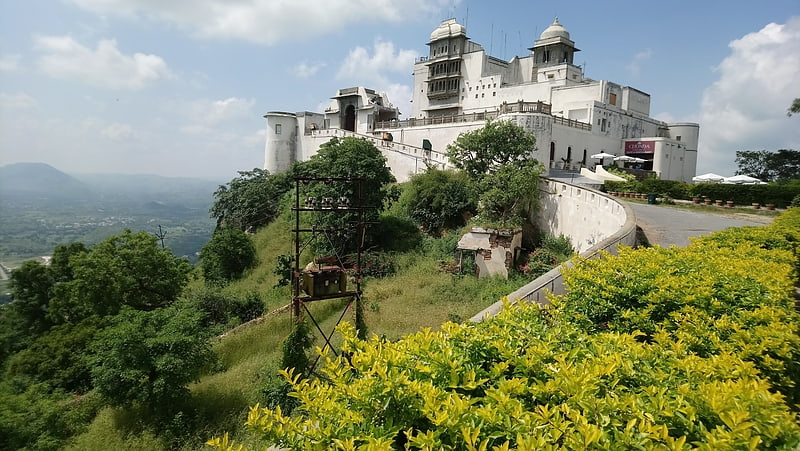
Also known as: मानसून भवन, उदयपुर
Palace in Kodiyat, India. The Monsoon Palace, also known as the Sajjan Garh Palace, is a hilltop palatial residence in the city of Udaipur, Rajasthan in India, overlooking the Fateh Sagar Lake. It is named Sajjangarh after Maharana Sajjan Singh of the Mewar Dynasty, who it was built for in 1884. The palace offers a panoramic view of the city's lakes, palaces and surrounding countryside. It was built chiefly to watch the monsoon clouds; hence, appropriately, it is popularly known as Monsoon Palace. It is said that the Maharana built it at the top of the hill to get a view of his ancestral home, Chittorgarh. Previously owned by the Mewar royal family, it is now under the control of the Forest Department of the Government of Rajasthan and has recently been opened to the public. The palace provides a beautiful view of the sunset.
Its builder, Maharana Sajjan Singh, originally planned to make it a five-storey astronomical centre. The plan was cancelled with Maharana Sajjan Singh's premature death. It was then turned into a monsoon palace and hunting lodge.
High in the Aravalli Hills, just outside Udaipur, the Palace is illuminated in the evenings, giving a golden orange glow (see image in the infobox). The palace was used in the 1983 James Bond film Octopussy as the residence of Kamal Khan, an exiled Afghan prince.[28]
Charminar, Hyderabad
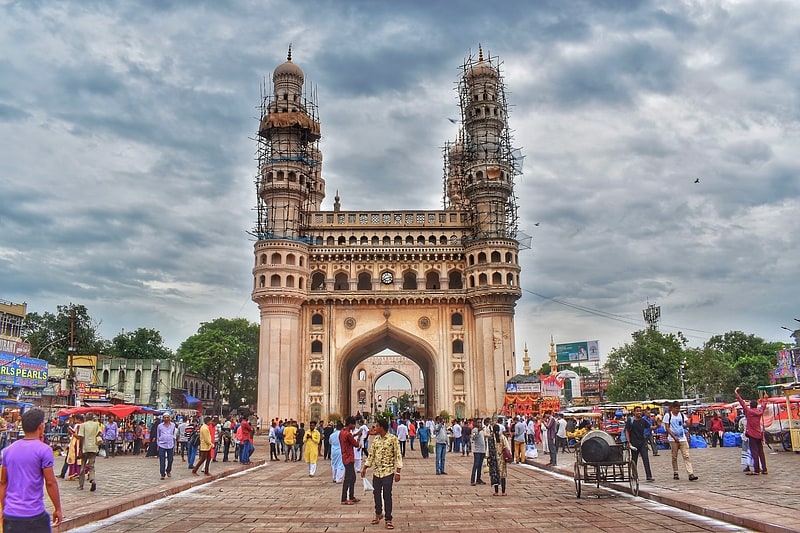
Also known as: चार मीनार
Iconic mosque with 4 minarets and arches. The Charminar constructed in 1591, is a monument located in Hyderabad, Telangana, India. The landmark has become known globally as a symbol of Hyderabad and is listed among the most recognised structures in India. It has also been officially incorporated as the Emblem of Telangana name=Symbol"Kakatiya arch, Charminar in Telangana state logo". The Deccan Chronicle. 30 May 2014. Retrieved 1 July 2015. The Charminar's long history includes the existence of a mosque on its top floor for more than 425 years. While both historically and religiously significant, it is also known for its popular and busy local markets surrounding the structure, and has become one of the most frequented tourist attractions in Hyderabad. Charminar is also a site of numerous festival celebrations, such as Eid-ul-adha and Eid al-Fitr, as it is adjacent to main mosque of the city Makkah Masjid across the road.
The Charminar is situated on the east bank of Musi river. To the west lies the Laad Bazaar, and to the southwest lies the richly ornamented granite Makkah Masjid. It is listed as an archaeological and architectural treasure on the official "List of Monuments" prepared by the Archaeological Survey of India. The English name is a translation and combination of the Urdu words chār and minar or meenar, translating to "Four Pillars"; the eponymous towers are ornate minarets attached and supported by four grand arches.[29]
Address: Charkaman, Charminar, 500082 Hyderabad (Erstwhile Circle-II)
Golconda Fort, Hyderabad
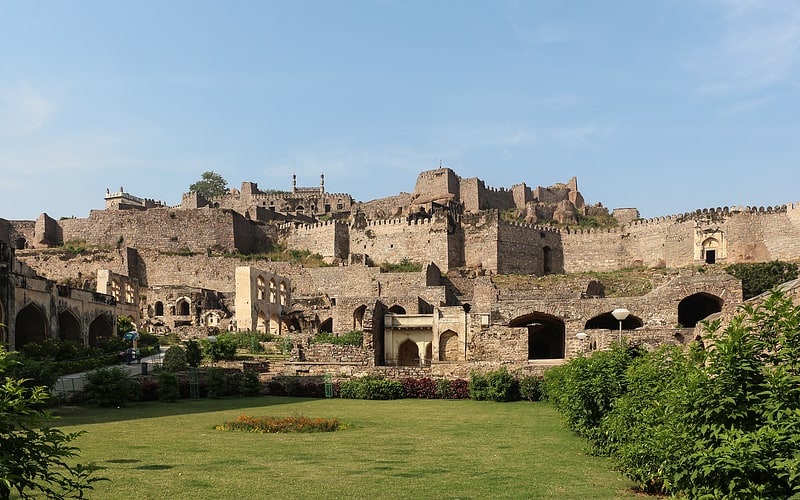
Also known as: गोलकोण्डा
Fortress complex famed for acoustics. Golconda Fort, (also known as Golla konda, is a fortified citadel built by the Qutb Shahi dynasty, located in Hyderabad, Telangana, India. Because of the vicinity of diamond mines, especially Kollur Mine, Golconda flourished as a trade centre of large diamonds, known as the Golconda Diamonds. The region has produced some of the world's most famous diamonds, including the colourless Koh-i-Noor, the blue Hope, the pink Daria-i-Noor, the white Regent, the Dresden Green, and the colourless Orlov, Nizam and Jacob, as well as the now lost diamonds Florentine Yellow, Akbar Shah and Great Mogul.
The complex was put by UNESCO on its "tentative list" to become a World Heritage Site in 2014, with others in the region, under the name Monuments and Forts of the Deccan Sultanate (despite there being a number of different sultanates).[30]
Address: Darbar hall, Hyderabad (Erstwhile Circle-IV)
Kankaria Lake, Ahmedabad

Also known as: कांकरीया झील
Lake in India. Kankaria Lake is the second largest lake in Ahmedabad, Gujarat, India. It is located in the south-eastern part of the city, in the Maninagar area. It was completed in 1451 during the reign of Sultan Qutb-ud-Din Ahmad Shah II though its origin is placed in the Chaulukya period sometimes. A lakefront is developed around it, which has many public attractions such as a zoo, toy train, kids city, tethered balloon ride, water rides, water park, food stalls, and entertainment facilities. The lakefront was revamped in 2007–2008. Kankaria Carnival is a week-long festival held here in the last week of December. Many cultural, art, and social activities are organised during the carnival.[31]
Lake Pichola, Udaipur
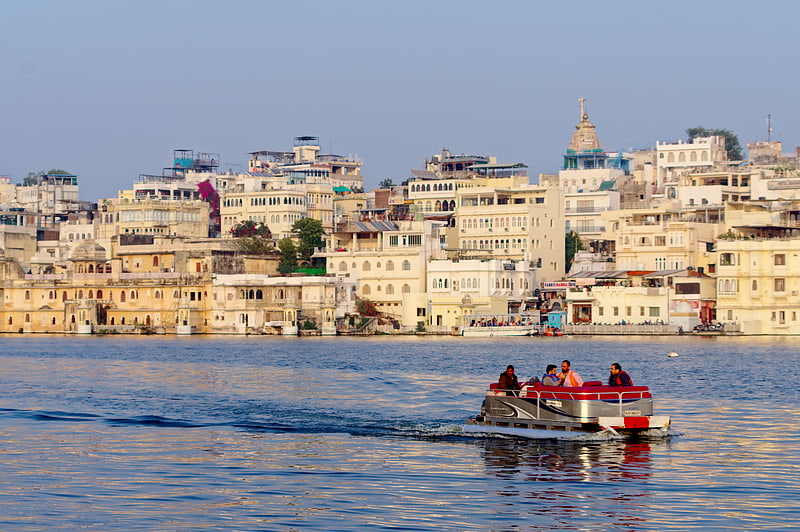
Also known as: पिछोला झील
Lake in India. Lake Pichola, situated in Udaipur city in the Indian state of Rajasthan, is an artificial fresh water lake, created in the year 1362 AD, named after the nearby Picholi village. It is one of the several contiguous lakes, and developed over the last few centuries in and around the famous Udaipur city. The lakes around Udaipur were primarily created by building dams to meet the drinking water and irrigation needs of the city and its neighbourhood. Two islands, Jag Niwas and Jag Mandir are located within Pichola Lake, and have been developed with several palaces to provide views of the lake.
There are four islands on the lake:
- Jag Niwas, where the Lake Palace is built.
- Jag Mandir, with the palace of the same name.
- Mohan Mandir, from where the king would watch the annual Gangaur festival celebration.
- Arsi Vilas, small island which was an ammunition depot, but also a small palace. This one was built by one of the Maharanas of Udaipur to enjoy the sunset on the lake. It is also a sanctuary catering to a variety of birds, including tufted ducks, coots, egrets, terns, cormorants and kingfishers.
Three of the numerous lakes found in the vicinity of Udaipur which connect with the Pichola lake and the Swaroop Sagar Lake connected by an arched bridge built by Maharana Swaroop Singh (1842-1861) which in turn connects to the Fateh Sagar Lake, the crystal watered lake in the midst of tree lined hills and the smaller Arsi Vilas.[32]
Pancha Rathas, Mamallapuram

Historic temples sculpted like chariots. Pancha Rathas is a monument complex at Mahabalipuram, on the Coromandel Coast of the Bay of Bengal, in the Kancheepuram district of the state of Tamil Nadu, India. Pancha Rathas is an example of monolithic Indian rock-cut architecture. The complex was initially thought to have carved during the reign of King Narasimhavarman I However, historians such as Nagaswamy attributed all of monuments in Mahabalipuram to Narasimhavarman II with the discovery of new inscriptions. The complex is under the auspices of the Archaeological Survey of India and is part of the UNESCO World Heritage site inscribed by UNESCO as Group of Monuments at Mahabalipuram.
Each of the five monuments in the Pancha Rathas complex resembles a chariot (ratha), and each is carved over a single, long stone or monolith, of granite which slopes in north–south direction with a slight incline. Though sometimes mistakenly referred to as temples, the structures were never consecrated because they were never completed following the death of Narasimhavarman I. The structures are named after the Pancha Pandavas and their common wife Draupadi, of epic Mahabharata fame. In order of their size, they include the Dharmaraja Ratha, Bhima Ratha, Arjuna Ratha, Nakula Sahadeva Ratha, and Draupadi Ratha.[33]
Address: Kancheepuram District, Mamallapuram
Shaniwar Wada, Pune
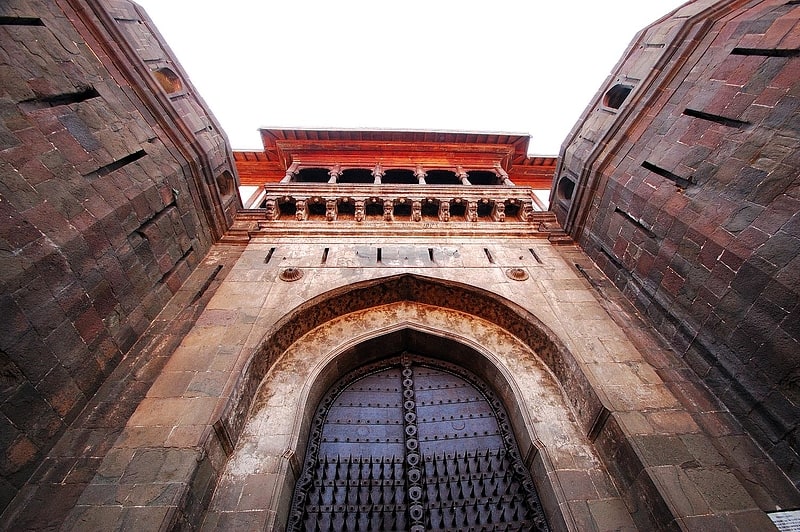
Also known as: शनिवार वाड़ा
Fortification in Pune, India. Shaniwar Wada is a historical fortification in the city of Pune, India.
Built in 1732, it was the great seat of the Peshwas of the Maratha Empire until 1818. Following the rise of the Maratha Empire, the palace became the center of Indian politics in the 18th century.
The fort itself was largely destroyed in 1828 by an unexplained fire, but the surviving structures are now maintained as a tourist site.[34]
Address: Shaniwar Peth, 411030 Pune
AlphaOne Mall, Ahmedabad

Shopping mall in Ahmedabad, India. Ahmedabad One is a shopping mall located at Vastrapur, Ahmedabad, India. The mall was opened in October 2011 and is the largest mixed used city centre in Ahmedabad.[35]
Devaraja Market, Mysore

Devaraja Market is a market located in Mysuru. One can buy flowers, fruits, and choose from conical piles of colorful Kumkum powder. Spices, sandalwood products, silk saris, essential oils, and incense are also available for purchase. The market is on Sayaji Rao Road. In 2017, there were 1,122 shops in the market employing over 3,000 people and receiving 8,000 to 10,000 visitors each day. It is a tourist attraction, and a popular place to take photos.
The market was constructed in 1886. It was initially a weekly market. The market was built above the Dewan Poornaiah Canal that supplied drinking water to Mysore Palace. It was named in 1925 after Dodda Devaraja Wadeyar. It is also known as Dodda market.
Its area spans 3.67 acres. The market is bounded by a structure with wooden rafters and stone masonry walls that faces the street on all four sides. The north gate is on Devantri Road. The market is bounded by Sayaji Rao Road on the east side. The south gate faces Dufferin Clock Tower. Inside the market, there are open areas where vendors can sell their wares. The inner shops are arranged along three aisles that go through the entire market.
Throughout the years, Devaraja Market has also seen fires and other disasters. 150 shops were destroyed by fire in 1981, 175 in 1990, and 30 in 1999. In August 2016, the north entrance gate collapsed due to structural weakness. There have been discussions about demolishing the market due to the state of disrepair.[36]
Golden Temple, Amritsar
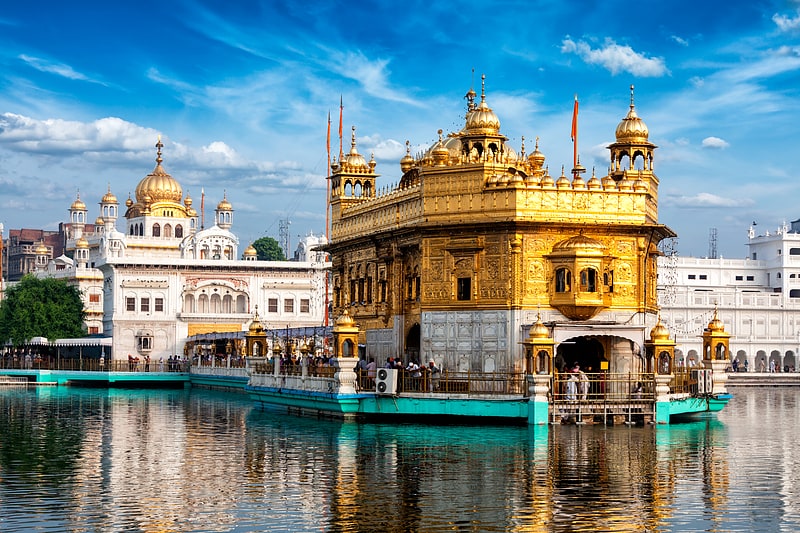
Also known as: हरिमन्दिर साहिब
Gilded temple and Sikh pilgrimage site. The Golden Temple is a gurdwara located in the city of Amritsar, Punjab, India. It is the preeminent spiritual site of Sikhism.
The man-made pool on the site of the temple was completed by the fourth Sikh Guru, Guru Ram Das, in 1577. In 1604, Guru Arjan placed a copy of the Adi Granth in Harmandir Sahib. The Gurdwara was repeatedly rebuilt by the Sikhs after it became a target of persecution and was destroyed several times by the Mughal, political parties and invading Afghan armies. Maharaja Ranjit Singh, after founding the Sikh Empire, rebuilt it in marble and copper in 1809, and overlaid the sanctum with gold leaf in 1830. This has led to the name the Golden Temple.
The Golden Temple is spiritually the most significant shrine in Sikhism. It became a centre of the Singh Sabha Movement between 1883 and 1920s, and the Punjabi Suba movement between 1947 and 1966. In the early 1980s, the Gurdwara became a centre of conflict between the Indian government and a radical movement led by Jarnail Singh Bhindranwale. In 1984, Prime Minister Indira Gandhi sent in the Indian Army as part of Operation Blue Star, leading to deaths of over 1,000 soldiers and civilians, as well as causing much damage to the Gurdwara and the destruction of Akal Takht. The Gurdwara complex was rebuilt again after the 1984 damage.
The Golden Temple is an open house of worship for all people, from all walks of life and faiths. It has a square plan with four entrances, and a circumambulation path around the pool. The four entrances to the temple symbolises the Sikh belief in equality and the Sikh view that all people are welcome into their holy place. The complex is a collection of buildings around the sanctum and the pool. One of these is Akal Takht, the chief centre of religious authority of Sikhism. Additional buildings include a clock tower, the offices of the Gurdwara Committee, a Museum and a langar – a free Sikh community–run kitchen that offers a vegetarian meal to all visitors without discrimination. Over 100,000 people visit the holy shrine daily for worship. The Gurdwara complex has been nominated as a UNESCO World Heritage Site, and its application is pending on the tentative list of UNESCO.[37]
Address: Harmandir Sahib, Amritsar
VGP Universal Kingdom, Chennai
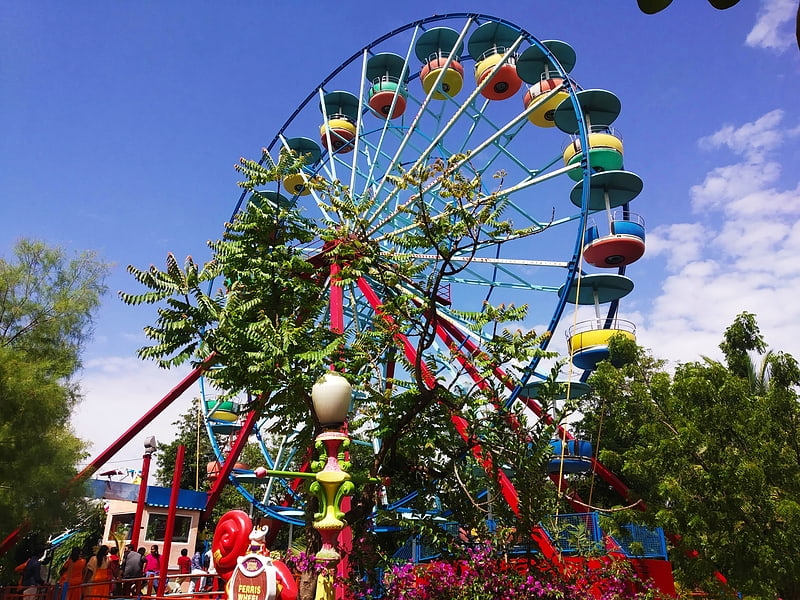
Amusement park in Chennai, India. VGP Universal Kingdom is an amusement park located in East Coast Road in Chennai, Tamil Nadu, India. The park offering small rides during the early days of its history became a full-fledged amusement park in 1997. VGP Universal kingdom, spread over 44 verdant acres provides several fun and adventure rides for children, youth and adults, including Attractions such as our very own Statue Man, Tamil Nadu's first Snow park, Petting Zoo, Beach Live Shows, Paneer fort, a massive water complex and more. VGP 2000 millennium tower, Water cascades, Paneer fort and statueman are some of the main attractions. The park is owned by VGP Group of Companies founded by V. G. Panneerdas and V.G.Ravidas is its managing director. Food and drink are available within the park.[38]
Address: East Coast Road, 600115 Chennai (Madras)
Shore Temple, Mamallapuram
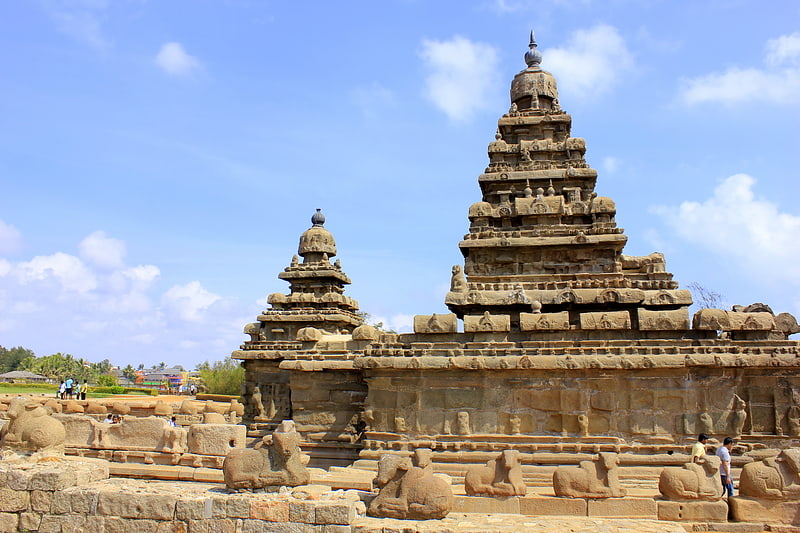
Also known as: महाबलिपुरम के तट मन्दिर
8th-century complex of 3 temples. The Shore Temple is a complex of temples and shrines that overlooks the shore of the Bay of Bengal. It is located in Mahabalipuram, about 60 kilometres south of Chennai in Tamil Nadu, India.
It is a structural temple, built with blocks of granite, dating from the 8th century AD. At the time of its creation, the site was a busy port during the reign of Narasimhavarman II of the Pallava dynasty. As one of the Group of Monuments at Mahabalipuram, it has been classified as a UNESCO World Heritage Site since 1984. It is one of the oldest structural (versus rock-cut) stone temples of South India.[39]
Botanical Gardens, Ooty
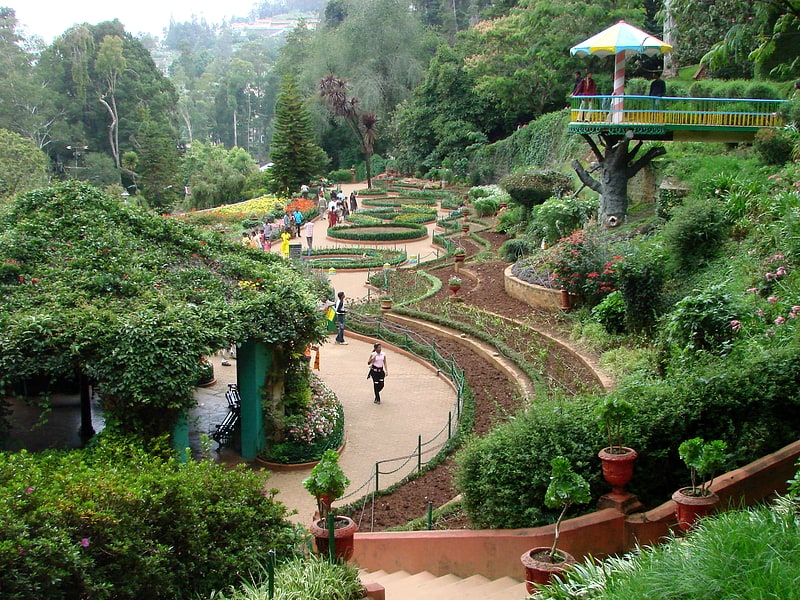
Botanical garden in Ooty, India. The Government Botanical Garden is a botanical garden in Udhagamandalam, near Coimbatore, Tamil Nadu state, India laid out in 1848. The Gardens, divided into several sections, cover an area of around 55 acres, and lie on the lower slopes of Doddabetta peak. The garden has a terraced layout. It is maintained by the Tamil Nadu Horticulture Department.
It ascends the slopes of the hill at an elevation of 2250–2500 metres above Mean Sea Level. The garden enjoys a temperate climate, with an average rainfall of 140 cm, the most of which is received during south-west monsoon, with frosty nights from November to February. The maximum and minimum temperatures are 28°C and 0°C respectively.[40]
Address: Botanical Garden Rd, 643001 Ooty
Ampa Skywalk, Chennai
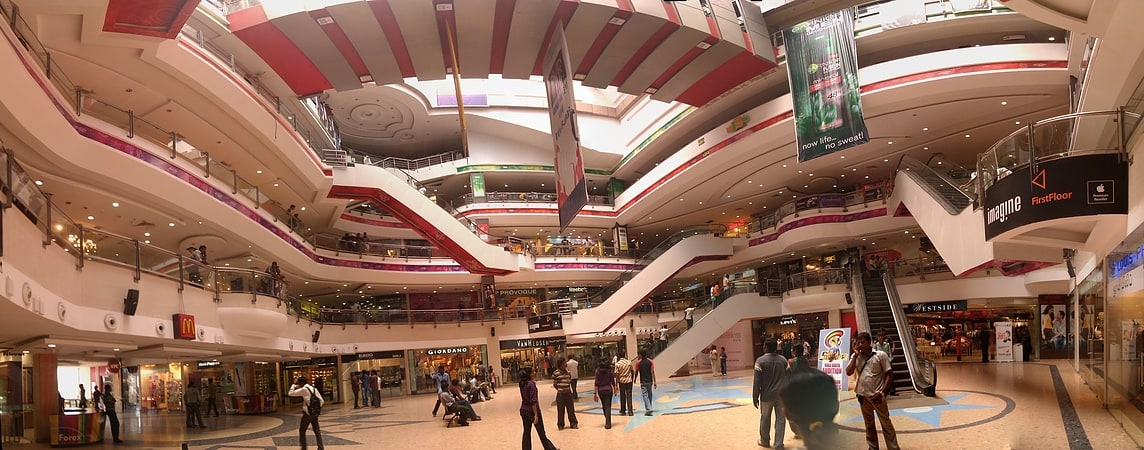
Shopping mall in Chennai, India. Ampa Skywalk is a shopping mall in Chennai, India. With three floors of retail space, it has outlets for major clothing and apparel brands, a seven-screen multiplex, a games zone and a food court.[41]
Address: Chennai, Poonamallee High Road
Arjuna's Penance, Mamallapuram
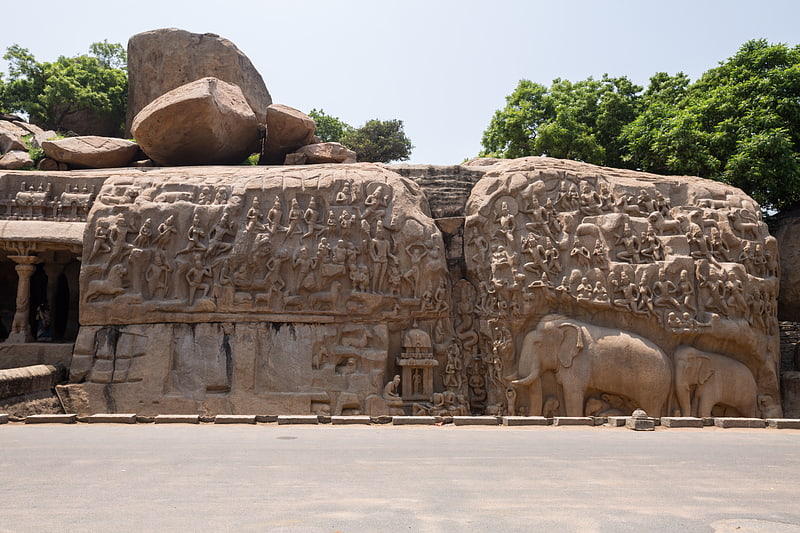
Also known as: गंगावतरण शैल
Descent of the Ganges is a monument at Mamallapuram, on the Coromandel Coast of the Bay of Bengal, in the Chengalpattu district of the state of Tamil Nadu, India. Measuring 96 by 43 feet, it is a giant open-air rock relief carved on two monolithic rock boulders. The legend depicted in the relief is the story of the descent of the sacred river Ganges to earth from the heavens led by Bhagiratha. The waters of the Ganges are believed to possess supernatural powers. The descent of the Ganges and Arjuna's Penance are portrayed in stone at the Pallava heritage site. The relief is more of a canvas of Indian rock cut sculpture at its best not seen anywhere in India. It is one of the Group of Monuments at Mamallapuram that were designated as a UNESCO World Heritage Site since 1984.[42]
Address: West Raja Street, 603104 Mahabalipuram
Goa Science Centre, Panaji
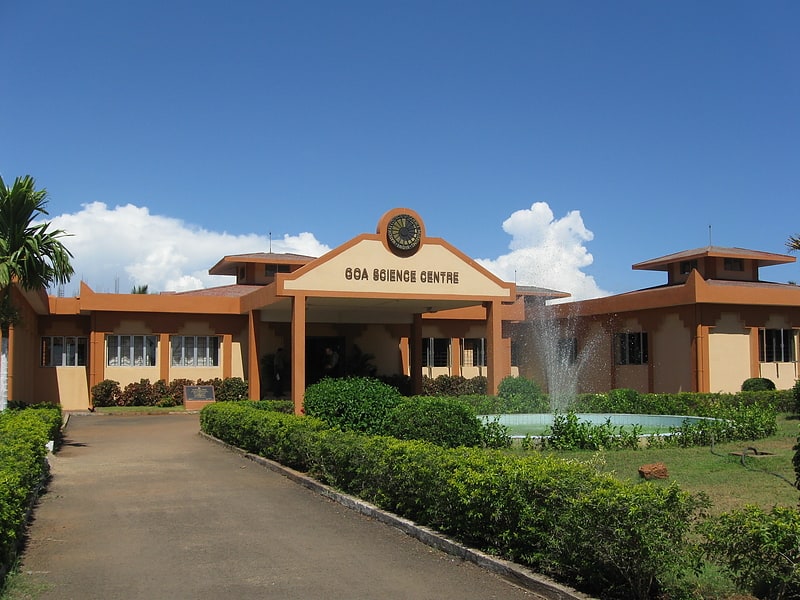
Museum in Panaji, India. The Goa Science Centre is a science museum is located on New Marine Highway, Miramar, Panjim. It is a joint project of a division of India's National Council of Science Museums and Goa's Department of Science Technology & Environment.[43]
Santhome Church, Chennai
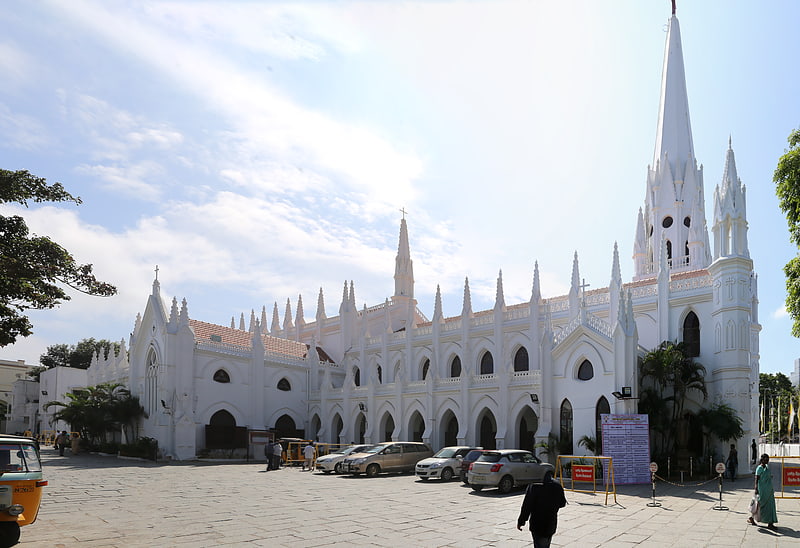
Basilica and shrine of St. Thomas Apostle. San Thome Church, is known as St. Thomas Cathedral Basilica and National Shrine of Saint Thomas, is a Roman Catholic minor basilica in the Santhome neighbourhood of the city of Madras, in Tamil Nadu, India. The present structure dates to 1523 AD, when it was built by the Portuguese, over the tomb of Thomas the Apostle, one of the apostles of Jesus. In 1896, it was rebuilt in British Madras according to Neo-Gothic style, as was favoured by British architects in the late 19th century. This church is one of the three known churches in the world built over the tomb of an apostle of Jesus that are still standing today, the other two being St Peter's Basilica in Vatican City and Santiago de Compostela Cathedral in Galicia, Spain. In antiquity, there was a basilica built over the tomb of the Apostle Philip in Hierapolis of Phrygia, near modern day Pamukkale.[44]
Address: 38, San Thome High Road, 600004 Chennai (Adyar)
Dal Lake, Srinagar
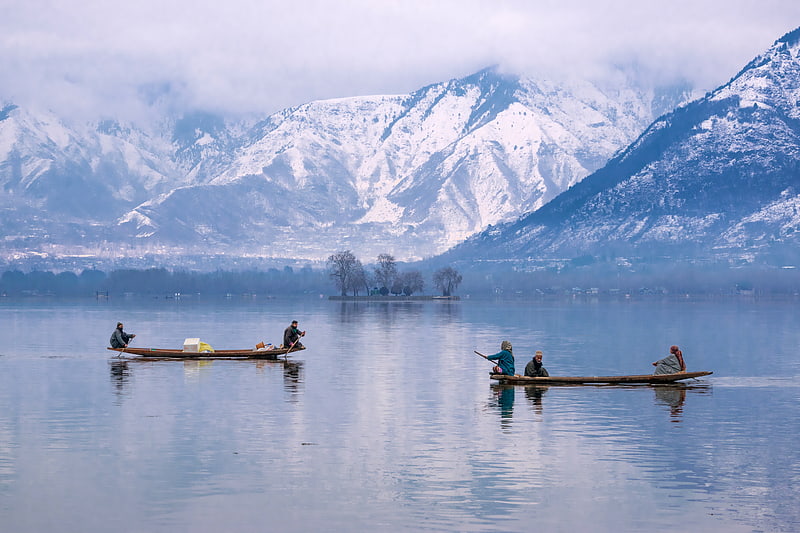
Also known as: डल झील
Lake in Asia. Dal is a lake in Srinagar, the summer capital of Jammu and Kashmir. It is an urban lake, which is the second largest in the union territory of Jammu and Kashmir. It is the most visited place in Srinagar by tourists and locals. It is integral to tourism and recreation in Kashmir and is named the "Lake of Flowers", "Jewel in the crown of Kashmir" or "Srinagar's Jewel". The lake is also an important source for commercial operations in fishing and water plant harvesting.
The shore line of the lake, about 15.5 kilometres (9.6 mi), is encompassed by a boulevard lined with Mughal era gardens, parks, houseboats and hotels. Scenic views of the lake can be witnessed from the shore line Mughal gardens, such as Shalimar Bagh and Nishat Bagh built during the reign of Mughal Emperor Jahangir and from houseboats cruising along the lake in the colourful shikaras. During the winter season, the temperature sometimes reaches −11 °C (12 °F), freezing the lake.
The lake covers an area of 18 square kilometres (6.9 sq mi) and is part of a natural wetland which covers 21.1 square kilometres (8.1 sq mi), including its floating gardens. The floating gardens, known as "Rad" in Kashmiri, blossom with lotus flowers during July and August. The wetland is divided by causeways into four basins; Gagribal, Lokut Dal, Bod Dal and Nigeen (although Nigeen is also considered as an independent lake). Lokut-dal and Bod-dal each have an island in the centre, known as Rup Lank (or Char Chinari) and Sona Lank respectively.
At present, the Dal and its Mughal gardens, Shalimar Bagh and the Nishat Bagh on its periphery are undergoing intensive restoration measures to fully address the serious eutrophication problems experienced by the lake. Massive investments of approximately US$275 million (₹ 11 billion) are being made by the Government of India to restore the lake to its original splendour.[45]
Basilica of Bom Jesus, Old Goa
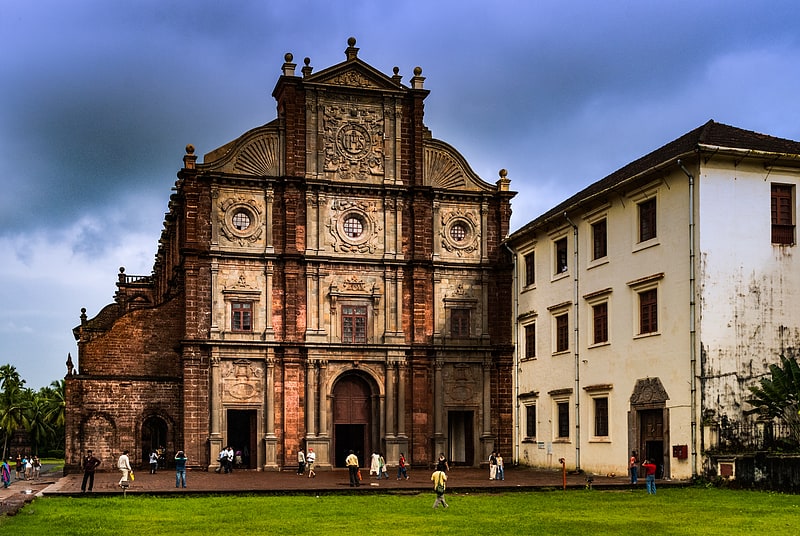
UNESCO-listed Baroque Catholic church. The Basilica of Bom Jesus is a Roman Catholic basilica located in the Goa state, situated in the Konkan region of India. It is both a pilgrimage centre and also the most iconic monument of all the churches and convents of Goa, recognised by UNESCO as a World Heritage Site. The basilica is located in Old Goa, former capital of Portuguese India, and holds the mortal remains of St Francis Xavier.
Bom Jesus (literally, "Good/ Holy Jesus" in Indo-Portuguese) is the name used for the Ecce Homo in countries of the Lusosphere. This Jesuit church is India's first minor basilica, and is considered to be one of the best examples of baroque architecture and Portuguese Colonial architecture in India. It is one of the Seven Wonders of Portuguese Origin in the World.
Pope Pius XII raised this sanctuary to the status of basilica via the Pontifical decree “Priscam Goae” on 20 March 1946. Signed and notarized by Cardinal Giovanni Battista Montini.[46]
Address: Old Goa, 403402 Panjim
Udayagiri, Bhubaneswar
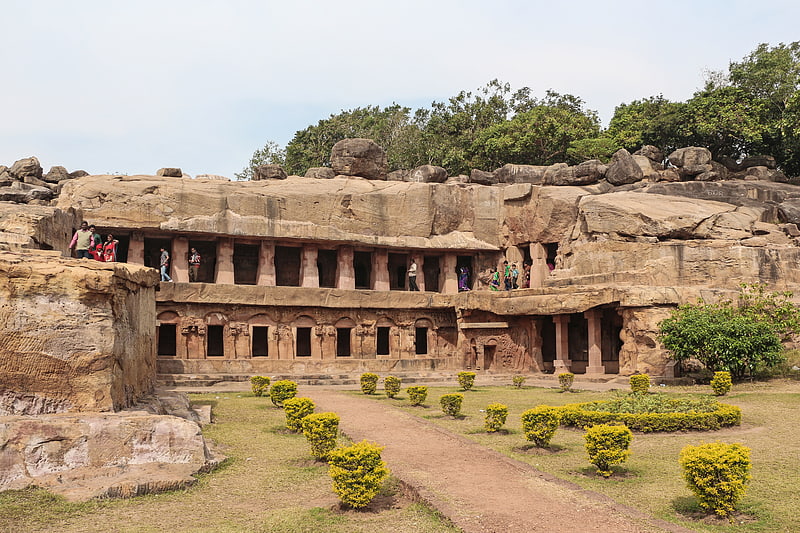
Also known as: उदयगिरि और खंडगिरि
Tourist attraction in Bhubaneswar, India. Udayagiri and Khandagiri Caves, formerly called Kattaka Caves or Cuttack caves, are partly natural and partly artificial caves of archaeological, historical and religious importance near the city of Bhubaneswar in Odisha, India. The caves are situated on two adjacent hills, Udayagiri and Khandagiri mentioned as Kumari Parvata in the Hathigumpha inscription. They have a number of finely and ornately carved caves built during the 1st century BCE. It is believed that most of these caves were carved out as residential blocks for Jaina monks during the reign of King Kharavela. Udayagiri means "Sunrise Hill" and has 18 caves while Khandagiri has 15 caves.
The caves of Udayagiri and Khandagiri, called lena or leṇa in the inscriptions, were dug out mostly during the reign of Kharavela for the abode of Jaina ascetics. The most important of this group is Ranigumpha in Udayagiri which is a double storeyed monastery. Other important caves include Hathi Gumpha, Ananta Gumpha, Ganesha Gumpha, Jaya Vijaya Gumpha, Mancapuri Gumpha, Bagha/Byaghra/Vyaghra Gumpha and Sarpa Gumpha.
Archaeological Survey of India has listed Udayagiri and Khandagiri Caves in the list of "Must See" Indian Heritage.[47]
Address: Digambara Jaina Temple khandgiri, Bhubaneswar
Ramgarhia Bunga, Amritsar
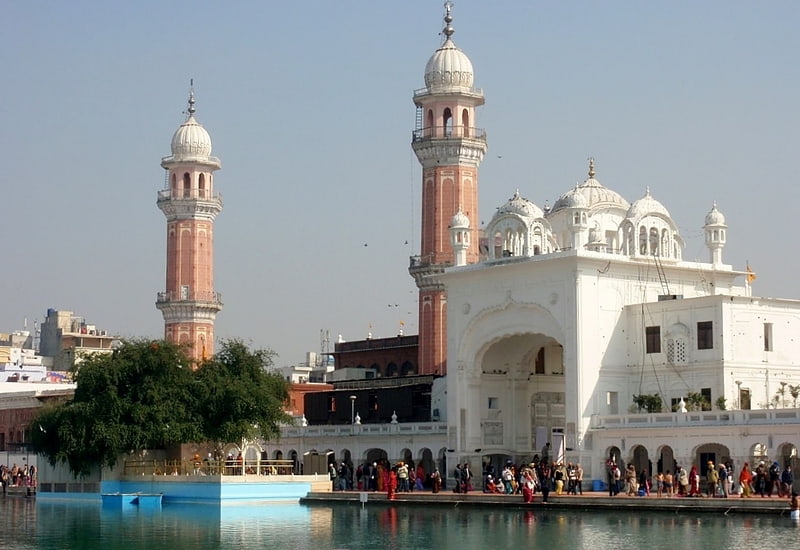
Historical landmark in India. Ramgarhia Bunga or Burj is the three-storeyed red stone watchtowers complex located near southeastern edge of the Golden Temple, Amritsar. The two minaret-style Ramgarhia Bunga high towers are visible from the parikrama walkway around the Harmandir Sahib Sarovar. It is a pre-Ranjit Singh structure built by Sikh warrior and Ramgarhia misl chief Jassa Singh Ramgarhia in late 18th-century, after the 1762 destruction and desecration of the Sikh holy temple and site by the Afghan Muslim forces led by Ahmed Shah Abdali. The Bunga watchtowers-related infrastructure was constructed to station sentinels to watch for any surprise attack, house soldiers to help fortify the area, and to protect the holy complex from desecration.
The Ramgarhia Bunga houses the granite slab of Takht-e-Taus from the Red Fort on which, according to the oral tradition, all the Mughal emperors were crowned in Delhi. This slab was seized by Sikhs from Delhi, during an attack against the Mughal armies, and brought back to Amritsar as a symbol that the Mughal Empire will end with the removal of their coronation stone.[48]
Churches and convents of Goa, Old Goa
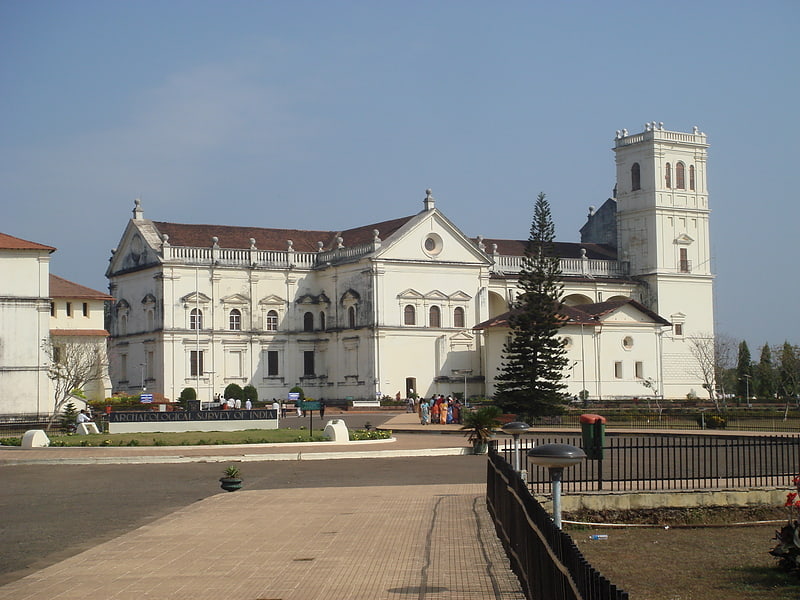
Churches and Convents of Goa is the name given by UNESCO to a set of religious monuments located in Goa Velha, in the state of Goa, India, which were declared a World Heritage Site in 1986.
Goa was the capital of Portuguese India and Asia and an evangelization center from the sixteenth century. The justifications for the inclusion of religious monuments in Goa in the World Heritage List are: 1) the influence of the monuments in the dissemination of Western art forms – the Manueline styles, Mannerist and Baroque – throughout Asia where Catholic missions were established; 2) the value of the set of monuments of Goa as an exceptional example that illustrates the work of evangelization and 3) the specific value of presence in the Basilica of Bom Jesus of the tomb of Francisco Xavier, which illustrates a major world event: the influence of the Catholic religion in Asia in the modern era.[49]
Indira Gandhi Planetarium, Patna
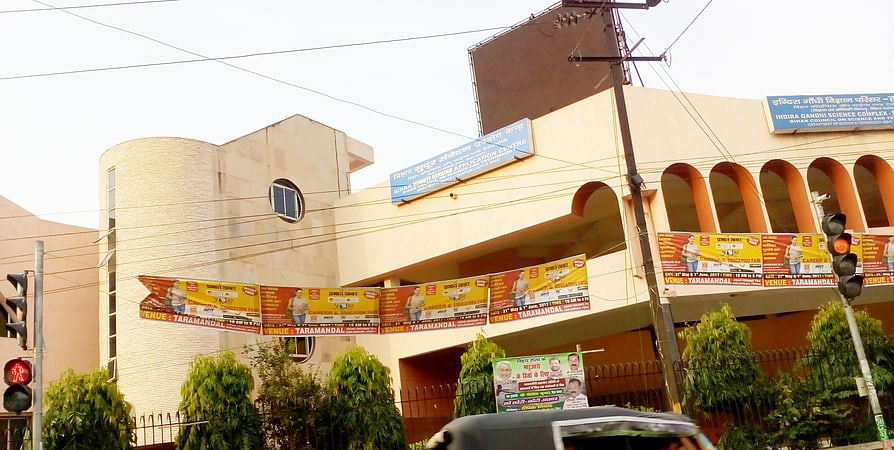
Also known as: पटना तारामंडल
The Indira Gandhi Planetarium, also known as the Patna Planetarium, is located in Patna's Indira Gandhi Science Complex. The planetarium was constructed through Bihar Council on Science & Technology at a total cost of about ₹110 million. It was conceptualised in 1989 by Bihar Chief Minister Shri Satyendra Narain Sinha with construction commencing in the same year, and opened for the public from 1 April 1993. It is named after senior Indian National Congress leader and former Prime Minister of India Indira Gandhi.
The Indira Gandhi Planetarium is one of the largest planetariums in Asia. It attracts many domestic as well as foreign tourists. The planetarium has regular film shows on subjects related to astronomy. It also holds exhibitions, which attract many visitors.
The planetarium uses traditional opto-mechanical projection of celluloid film.[50]